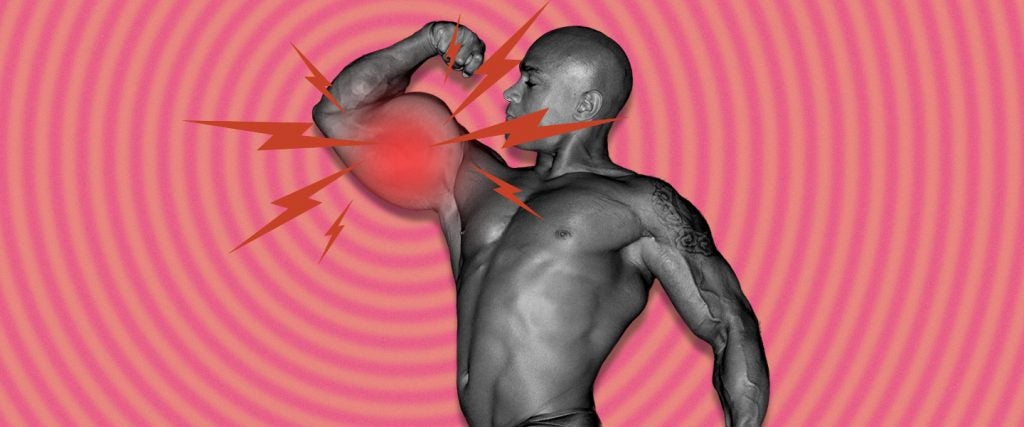I never fully endured the unholy discomfort of leg day until I got roped into regular Sunday leg-training sessions by several of the stronger, more ambitious trainers at the Bally Total Fitness Executive Club. The fatigue and discomfort would take up residence in my legs by the end of the third set of squats, which meant I was in absolute misery during the lunges, leg presses, seated leg curls and seated leg extensions. By the time it was all over with, I was the physical embodiment of defeat. It may very well have taken me two minutes to ascend the 16 or so steps to the cardio floor in order to cool down on the elliptical.
As miserable as that was, that Sunday afternoon soreness was nothing compared to the Monday morning misery that awaited my legs — their every cell would permeate with pain. Then, when I’d arrive at the gym, the leader of our training sessions, Chris, would shoot me a smile as I staggered around the lobby, knowing that we were bound by our shared muscle soreness, and that we would both eventually enjoy the benefits heralded by the extreme discomfort of the present.
Were we right, though? Was all of that muscle soreness an essential precursor to muscle growth, or were we simply indulging in a misguided, unnecessary form of autosadism because we incorrectly assumed soreness was the key to big gains?
What causes muscle soreness in the first place?
This question may seem overly simplistic, but you need to understand that your muscles can experience soreness for myriad reasons that have nothing to do with strength training. That once-in-a-century feeling of soreness you find yourself taking pride in as the evidence of a plateau-busting workout may just be an early indicator of the flu. Or the tension you feel in your shoulders might be owed to a repetitive strain exacerbated by a full week of firing off countless reps in your CrossFit gym.
Yes, muscle soreness can be the result of productive, strength-building activities, but all things being equal, it’s more likely indicative of a negative consequence as opposed to a harbinger of good things to come.
Well, what happens to my muscles when I lift heavy weights?
I’m glad you asked this question, because so few people understand what’s happening when they’re going about the business of getting swole. The process of intentionally training to increase muscle size involves training for hypertrophy. When you train for hypertrophy and lift heavy weights, what you’re actually doing is intentionally and repeatedly tearing your muscles to effectuate a muscle building result.
No, I’m not talking about the full-blown muscle tears that cause muscle tissues to curl up beneath the skin, thereby producing odd-looking, misshapen arms that stand out glaringly on very muscular physiques. Instead, I’m talking about micro tears, which are the result of the muscle fibers being torn, and the pump you feel is the consequence of blood rushing to the site of the micro tears in order to repair them.
While you’re resting and recovering from your chest workout, your body is accounting for the destruction you subjected your chest to by rebuilding all of the muscle fibers to become bigger and stronger than before. It’s your body’s way of saying, “If this is the sort of thing this jerk is going to be putting us through on a regular basis, we’re going to be better prepared for it next time!”
So microtearing the muscle and rebuilding it is what causes the soreness?
Wrong. Muscle soreness is caused by two different things. The first is an accumulation of lactic acid in the areas of the body that are being trained. Your body produces lactic acid when it’s low in energy in a certain area, and then that lactic acid enters the bloodstream to provide you with small bits of energy. While this is in progress, the muscles feel cramped, sore and irritated. Fortunately, your body is able to clear the majority of the lactic acid from your system within a few hours of training.
Oh, it’s the lactic acid that’s making me sore.
No, that’s the result of something else. What you’re experiencing two days after leg day — when you’re wobbling around the neighborhood like a newborn deer — is delayed onset muscle soreness, aka “DOMS.” Lactic acid may play a tiny role in causing DOMS, but up to five other factors can contribute to it as well, including muscle spasms, connective tissue damage, muscle damage, inflammation and enzyme efflux.
This is why DOMS is most prevalent and pronounced in situations where a muscle group is being strenuously trained for the first time ever, or for the first time in a long time. The repercussions of long stretches of inactivity all coalesce into a single unpleasant experience that may last several days, and it might take several bouts of DOMS before your body develops the capability to endure everything and mitigates the damage.
But the soreness of DOMS isn’t a prerequisite for muscle growth?
Absolutely not. The soreness of your muscles doesn’t correlate with a 1:1 commensurate increase in muscle mass, strength or endurance, because not every component of your muscle soreness is connected to the micro-tearing and rebuilding of muscle fibers.
Instead of chasing soreness, devote yourself to providing your best effort to your training, with your muscles failing at the optimal moments, with your weights and repetitions falling within the ideal ranges, and with your technique as perfect as you can make it.
If you’re doing all of these things, you’ll be able to tell whether or not your muscles are growing in a desirable fashion with your own two eyes, which is a far more reliable indicator of muscle growth than an ephemeral feeling of soreness — or an embarrassing inability to walk properly.

